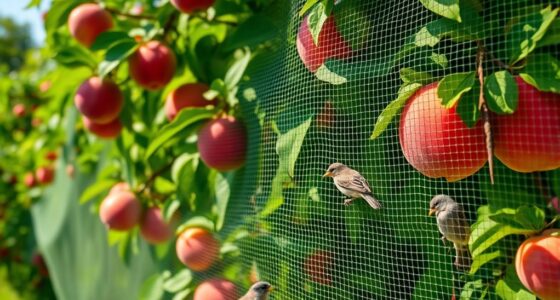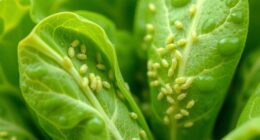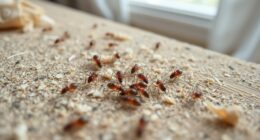Peach leaf curl shows up as distorted, curled, and swollen leaves with light-colored spots that darken over time. Wet, cool weather—especially during spring rains—favors fungal growth, making symptoms worse. Persistent humidity and temperatures between 60°F and 85°F encourage disease spread. If you want to spot early signs and understand how weather influences the infection, keep exploring these visual clues and environmental factors for better management.
Key Takeaways
- Early symptoms include reddish or purple spots that curl and distort leaves.
- Moist, humid, and rainy spring weather promotes fungal growth and disease spread.
- Cool, wet conditions with extended leaf wetness increase the risk of infection.
- Temperatures between 60°F and 85°F, especially 60°F–75°F, favor rapid fungal development.
- Poor soil nutrition and inadequate airflow weaken trees, making them more susceptible to leaf curl.
Recognizing the Visual Signs of Peach Leaf Curl

To identify peach leaf curl early, you need to know what to look for. You might notice distorted or swollen leaves, often with a reddish or yellowish hue. These changes can resemble early signs of root rot, where the plant’s vigor diminishes, but here, the issue affects the foliage. Pest infestation can sometimes mimic or exacerbate these symptoms, leading to curled or misshapen leaves covered with a powdery or velvety coating. Keep an eye out for leaves that appear thickened or have abnormal coloration, as these are typical visual signs. Early detection helps prevent the disease from spreading, so regularly inspecting your trees is crucial. Recognizing these signs ensures you catch peach leaf curl before it causes serious damage. Additionally, understanding the weather triggers such as wet, cool spring conditions can help you anticipate when the disease is most likely to develop.
How Discolored Leaves Indicate Disease Presence

Discolored leaves are often among the first clear indicators that your peach tree might be battling a disease like leaf curl. When you notice uneven or yellowing foliage, it signals potential disease indicators. These discolored leaves weaken the tree and reduce fruit production. Early detection helps manage the problem before it spreads. Use the table below to identify common symptoms linked to discolored leaves:
| Discolored Leaves | Possible Disease Indicators | Recommended Action |
|---|---|---|
| Yellowing edges | Nutrient deficiency, disease | Apply fertilization |
| Dark spots | Fungal infection | Apply fungicide |
| Blotchy patches | Leaf curl, virus | Remove affected leaves |
| Pale, dull color | Disease progression | Improve air circulation |
| Browning tips | Environmental stress | Adjust watering practices |
Recognizing these disease indicators early helps protect your peach tree from further damage. Proper diagnostics can aid in identifying the exact cause of leaf discoloration and ensure appropriate treatment.
The Impact of Twisted and Curling Foliage

When your peach leaves twist and curl, it’s a clear sign of underlying issues like leaf deformation. You’ll notice these patterns often worsen as the disease progresses or if environmental stressors, such as humidity or poor airflow, are present. Recognizing these signs early helps you understand how disease and conditions influence foliage changes. Implementing stress management techniques can help mitigate environmental factors that contribute to leaf curling and twisting.
Leaf Deformation Signs
Peach leaf curl often manifests through noticeable deformation of the foliage, especially as leaves begin to twist and curl. This change in peach leaf morphology signals that something is amiss. You might notice distorted, puckered, or curled leaves, which can suggest disease or nutrient issues. To understand this better, consider these points: 1. Twisted or curled leaves indicate abnormal growth and possible fungal infection. 2. Deformation might also signal leaf nutrient deficiencies, such as calcium or magnesium. 3. Examining the pattern of leaf deformation helps distinguish between disease symptoms and nutrient problems. Additionally, understanding the top 10 anime films can provide insights into cultural storytelling elements that parallel plant health narratives.
Disease Progression Patterns
Twisted and curling leaves are key indicators of how peach leaf curl disease progresses on affected trees. When you notice this deformation, it signals the disease is advancing, often starting with small, affected leaves that become distorted over time. Poor soil health can weaken the tree’s defenses, making it more susceptible to disease progression. Proper pruning techniques help manage the spread by removing infected twigs and improving air circulation, which can slow disease development. As the disease progresses, you’ll see more curled, distorted foliage and potential fruit deformities. Early intervention with fungicides and improved cultural practices can interrupt this pattern. Understanding these progression signs enables you to act promptly, reducing the severity of the disease on your peach trees. Additionally, local tips can provide tailored strategies for managing disease in specific climates or soil conditions.
Environmental Stress Factors
Environmental stress factors can markedly influence the development of twisted and curling foliage in peach trees. Poor soil nutrition weakens the plant, making it more susceptible to stress and abnormal leaf growth. Additionally, inadequate pest control allows insects to damage leaves, causing curling as a defensive response. To minimize these issues, consider these key points:
- Maintain balanced soil nutrition through proper fertilization.
- Regularly inspect and control pests to prevent leaf damage.
- Ensure ideal watering to reduce drought stress.
- Understanding angel number symbolism can help interpret signs of upcoming growth or change in your gardening journey.
Addressing soil nutrition and pest control helps keep foliage healthy, reducing the likelihood of twisting and curling. When environmental stressors are managed, trees are better equipped to resist weather triggers that exacerbate leaf curl symptoms.
Early Symptoms vs. Advanced Infection Stages

You’ll notice early symptoms like yellow or light green spots on the leaves, which can be easy to overlook. As the infection advances, you’ll see more fungal growth and darker, more pronounced leaf curling and distortion. Recognizing these signs early helps you act before the disease becomes severe. Monitoring environmental conditions such as humidity and temperature can also influence disease development and should be considered in your prevention strategy.
Initial Leaf Discoloration Patterns
Initially, peach leaf curl symptoms appear as small, reddish or purple spots on the upper surface of the leaves. As the discoloration develops, you’ll notice the spots enlarge and turn into thickened, puckered areas, signaling an advanced infection. Early discoloration may resemble nutrient deficiencies, so it is crucial to observe patterns carefully. To prevent progression, consider:
- Using proper pruning techniques to improve air circulation and reduce humidity, limiting fungal growth.
- Monitoring for early signs of discoloration to catch infections before they spread.
- Ensuring trees receive balanced nutrients, as deficiencies can mimic or exacerbate leaf curl symptoms.
- Staying informed about plant disease management strategies to better protect your peach trees.
Recognizing these initial patterns helps in timely intervention, reducing damage and supporting healthier peach trees.
Visible Fungal Growth Signs
As the peach leaf curl progresses, the presence of visible fungal growth becomes a key indicator of infection stages. In early signs, you might notice small, powdery patches on the leaf surface, indicating fungal spores beginning to develop. As the infection advances, these spores produce more prominent growths, often forming fuzzy or velvety textures around leaf lesions. These leaf lesions change from light-colored spots to darker, sunken areas as the fungus invades deeper tissues. The fungal spores spread easily through moist conditions, intensifying the infection. Recognizing these visible fungal growth signs helps you determine if the disease is at an early or more advanced stage, guiding timely interventions to prevent further damage.
Leaf Curling and Distortion
In the early stages of peach leaf curl, affected leaves begin to curl inward and distort, often showing puckered or crinkled edges. As the infection progresses, the distortion worsens, leading to crumpled, thickened foliage. To manage this, you should apply organic treatments promptly and consider pruning techniques to remove severely affected leaves.
You can also incorporate vibrational energy techniques to promote healthier plant growth and resilience.
Key points to keep in mind:
- Early leaf curling signals the start of infection, so act quickly.
- Pruning helps improve air circulation, reducing fungal spread.
- Organic treatments, like neem oil or copper sprays, are effective against initial symptoms.
Recognizing these signs early allows you to control the disease before it causes extensive damage.
The Role of Cool, Wet Conditions in Disease Development

Cool, wet conditions create an ideal environment for peach leaf curl to thrive. When moisture levels are high, fungal spores land on leaf surfaces and infect the tissue more easily. The dampness keeps spores moist, helping them germinate and spread rapidly. These conditions prevent the leaves from drying out, allowing the fungus to establish itself before the weather warms or dries. You’ll notice that during cool, rainy periods, the disease progresses faster because the fungi remain active longer. If you want to reduce disease development, it’s vital to understand how these moisture conditions support fungal growth. Keeping foliage dry when possible and improving air circulation can help decrease moisture levels and limit the spread of fungal spores. Additionally, understanding the impact of weather conditions on fungal activity can help gardeners better predict and manage outbreaks.
Seasonal Weather Patterns That Favor Peach Leaf Curl

Certain seasonal weather patterns create prime conditions for peach leaf curl to develop. Humid, moist springs with frequent rain and high humidity promote fungal growth. To reduce risk, consider planting disease resistant cultivars that resist infection. Proper soil nutrient management plays a key role in strengthening your trees’ defenses. Here are three critical factors to watch for:
Humid, moist springs with frequent rain promote peach leaf curl development.
- Consistently wet conditions during early spring increase infection chances.
- Extended periods of leaf wetness provide ideal fungal incubation sites.
- Lack of proper soil nutrients weakens tree health, making them more susceptible.
Temperature Ranges That Promote Fungal Growth

Fungal growth thrives within specific temperature ranges, which can vary for peach leaf curl. You’ll notice the disease spreads most rapidly when daytime temperatures stay between 60°F and 85°F. Sudden temperature fluctuations can also weaken your tree’s defenses, making it more susceptible.
Optimal Growth Temperatures
Ideal growth temperatures for peach leaf curl fungi typically range between 60°F and 75°F (15°C to 24°C). Within this range, the fungi thrive, making it easier for the disease to develop and spread. To manage this risk, consider these key points:
- Maintain good soil nutrition to support healthy trees and reduce stress that can make them more susceptible.
- Use proper pruning techniques to improve air circulation, decreasing humidity levels that favor fungal growth.
- Avoid excessive watering during these temperatures, as prolonged moisture on leaves encourages infection.
Temperature Fluctuations Impact
Temperature fluctuations can markedly influence the development of peach leaf curl fungi, especially when temperatures swing between warm days and cool nights. These shifts create ideal conditions for fungal spores to thrive and infect leaves. Consistent soil moisture from fluctuating temperatures can also promote fungal growth by keeping the plant tissues and surrounding environment damp. To reduce vulnerability, use proper pruning techniques to improve airflow and reduce humidity around the tree, making it less hospitable for the fungus. Avoid overwatering during warm spells, as excess soil moisture can exacerbate the problem. Sudden temperature drops can weaken the plant’s defenses, so maintaining stable conditions helps prevent outbreaks. Being mindful of these temperature fluctuations lets you better protect your peach trees from leaf curl.
The Effect of Spring Rainfall and Humidity

Spring rainfall and humidity play a crucial role in the development and spread of peach leaf curl. Wet conditions create an ideal environment for the fungal spores to infect leaves. Poor soil drainage can worsen this effect by keeping moisture around the roots and trunk, increasing overall humidity. To reduce risk, you should:
- Improve soil drainage around your trees to prevent excess moisture.
- Use proper pruning techniques to increase air circulation, reducing humidity levels.
- Avoid overwatering during wet spring periods, which can keep foliage damp longer.
These practices help minimize the conditions that favor fungal growth. By managing moisture and airflow, you reduce the chances of leaf curl developing or spreading during rainy, humid springs.
Environmental Factors Increasing Susceptibility

Certain environmental factors can make your peach trees more vulnerable to leaf curl. Poor soil drainage creates excess moisture around roots, weakening the tree’s defenses and encouraging fungal growth. When soil retains too much water, it stresses the tree, making it less capable of resisting infections like leaf curl. Additionally, pest interactions can increase susceptibility. Pests such as aphids and scale insects often feed on weakened tissues, creating entry points for the curling fungus. These pests can also transmit pathogens directly or cause wounds that facilitate infection. Together, poor soil drainage and pest interactions compromise your tree’s health, heightening the risk of leaf curl developing and spreading. Managing soil conditions and controlling pests are essential steps to reduce your tree’s vulnerability.
Timing Preventative Actions Based on Weather Trends

Monitoring weather patterns helps you determine the best times to apply preventative measures against peach leaf curl. When you track warm, wet conditions in early spring, you can time your treatments effectively. For example:
- Apply fungicides just before weather forecasts predict rain, as moisture encourages the disease to develop.
- Use pruning techniques to remove infected branches during dry periods, reducing sources of infection and improving airflow.
- Incorporate pest management strategies during dormant seasons to prevent secondary issues that weaken the tree’s defenses.
Frequently Asked Questions
Can Peach Leaf Curl Symptoms Appear on Other Parts of the Tree Besides Leaves?
Yes, peach leaf curl symptoms can appear on other parts of your tree besides leaves. Fungal spores can spread to young shoots, fruit, and stems, causing leaf discoloration and deformities. You might notice distorted shoots or blighted fruit, indicating the disease’s progression. Keep an eye out for these signs, as early treatment can help manage the spread. Regular inspections are key to protecting your tree’s overall health.
How Do Different Peach Cultivars Vary in Susceptibility to Leaf Curl?
You’ll find that different peach cultivars vary in susceptibility to leaf curl due to genetic variability. Some cultivars have higher resistance, meaning they’re less likely to develop symptoms, while others are more vulnerable. By selecting cultivars with known resistance or lower susceptibility, you can reduce the impact of leaf curl on your trees. Understanding this genetic variability helps you make better choices for a healthier, more resilient orchard.
Does Pruning Affect the Development or Spread of Peach Leaf Curl?
Think of pruning as opening the gates to your peach tree’s health. Pruning impacts disease spread by removing infected or dead branches, preventing the curl from taking hold. Proper pruning encourages good air circulation, reducing humidity that favors the fungus. However, over-pruning can create wounds that invite infection. So, you must prune wisely to control disease spread and keep your tree healthy and vibrant.
Are There Specific Weather Patterns That Signal an Imminent Outbreak?
You should watch for specific weather patterns that signal an imminent outbreak. Cool, wet conditions often lead to increased risk, as moisture promotes fungal growth. If you notice prolonged rain or high humidity over several days, it’s a good time to prepare for potential outbreaks. These weather patterns help with outbreak prediction, so staying alert during such periods can help you implement preventive measures effectively.
How Long Does It Typically Take for Symptoms to Develop After Weather Changes?
It’s no coincidence that leaf curl symptoms often appear within 1 to 2 weeks after weather changes. The leaf curl incubation period varies, but you typically see symptom progression quickly when conditions favor the fungus. Warm, moist weather accelerates the process, so if you notice weather shifts, monitor your trees closely. Symptoms can develop rapidly, making early detection key to managing the disease effectively.
Conclusion
By understanding how weather influences peach leaf curl, you can catch symptoms early and protect your trees. Did you know that cool, wet spring conditions increase infection risk by up to 80%? Staying vigilant during these times allows you to take timely action, reducing damage and ensuring healthy, fruitful trees. Keep an eye on weather patterns and act promptly—your peaches will thank you for it!









